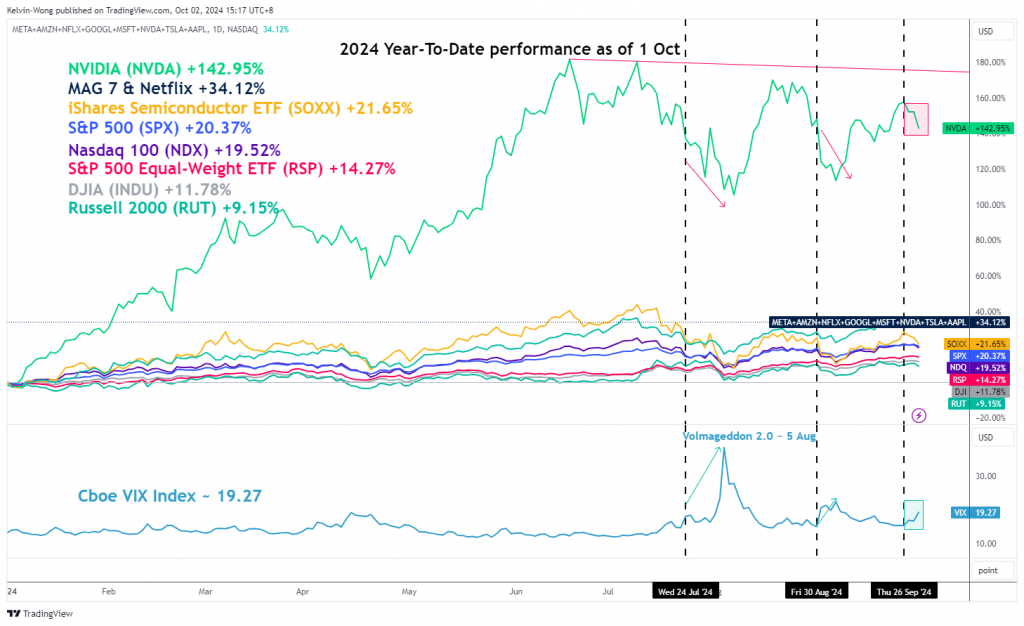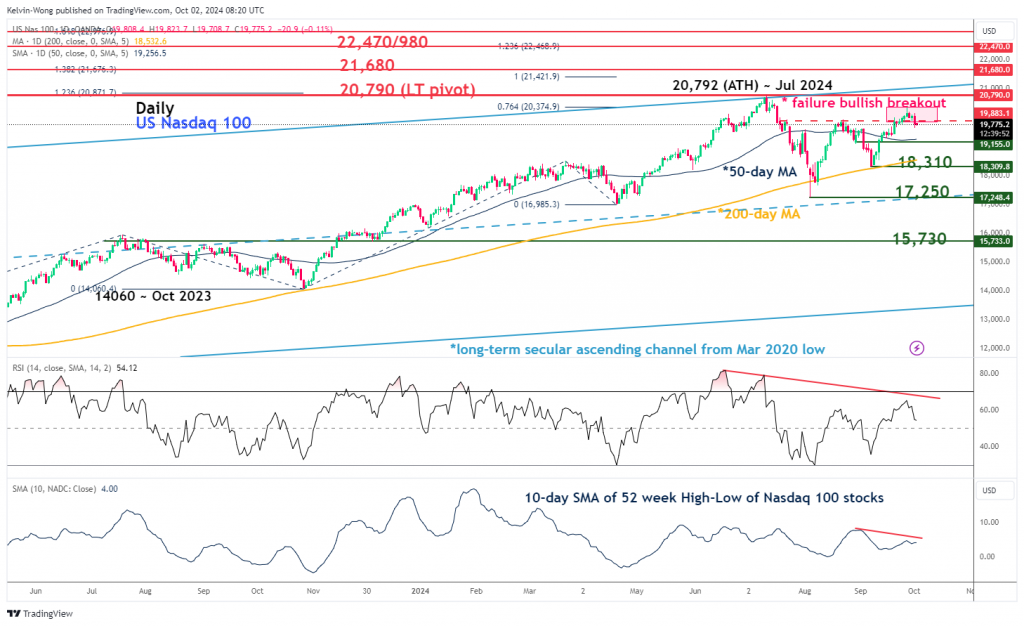- Nasdaq 100 has reintegrated back below its most recent medium-term swing high of 19,880.
- Nvidia is now showing leadership weakness which may trigger a jump in VIX, in turn setting up a potential multi-week corrective decline sequence in the Nasdaq 100.
- Market breadth has turned lacklustre as the Nasdaq 100 component stocks have recorded lesser new 52-week highs in the past four weeks.
The Nasdaq 100, a higher beta index among the major US stock indices due to its higher weighted concentration of growth-oriented artificial intelligence-related (AI) component stocks declined by 1.4% at the start of Q4 and 1 October, its worst daily performance since 6 September.
Yesterday’s bearish movement has been accentuated by a jump in geopolitical risk premiums in the Middle East where Iran unleashed a volley of missile attacks on Israel that may trigger a further rise in hostilities and with the possibility of more stakeholders such as the US and Russia being drawn into the ongoing Israel-Hamas war.
In this publication, we will highlight several technical analysis elements and inter-market dynamics that may trigger further potential weakness on the Nasdaq 100 over the medium-term horizon (multi-week to multi-month).
Nvidia is the weakest link
Fig 1: 2024 YTD performance of Nvidia & major US stock indices with VIX as of 1 Oct 2024 (Source: TradingView, click to enlarge chart)
Nvidia, the juggernaut AI GPU maker has been the stock market leader in the past two years, its 2024 year-to-date triple digits return of 142.95% as of 1 October has surpassed significantly other major US stock indices returns (S&P 500 +20.37%, Nasdaq 100 +19.52%, DJIA +11.78%, Russell 2000 +9.15%), and iShares Semiconductor sector ETF index (+21.65%).
However, since its current peak year-to-date return of +181.51% on 18 June, the performance of Nvidia has languished and triggered a jump on the VIX (the implied volatility of the S&P 500) on two occasions due to its weakness in price actions (see Fig 1).
Firstly, on 24 July, it led to a significant jump in the VIX from 18.03 to a closing level peak of 38.56 on 5 August (Volmageddon 2.0). The second occasion recorded was on 30 August when the VIX made a smaller scale increase from 15.01 to 22.37.
On the above-mentioned two occasions, the jumps seen in the VIX triggered a negative feedback loop into the price actions of the S&P 500 and Nasdaq 100 which saw multi-week corrective decline sequences over the same periods.
Right now, a similar price action weakness has been captured in Nvidia on 26 September where the VIX has shaped an increase to 19.27 as of Tuesday, 1 October from 15.36; a prelude to a potential looming multi-week corrective decline sequence on the S&P 500 and Nasdaq 100.
Market breadth has turned bearish on the Nasdaq 100
Fig 2: Nasdaq 100 CFD major & medium-term trends as of 2 Oct 2024 (Source: TradingView, click to enlarge chart)
Yesterday, 1 October price actions of the Nasdaq 100 CFD Index (a proxy of Nasdaq 100 E-mini futures) reintegrated back below its most recent medium-term swing high of 19,880 which indicates a possible failure bullish breakout scenario in the past week.
In addition, as the price actions of the Nasdaq 100 CFD Index scaled new higher swing highs on 22 August and 26 September, the 10-day moving average of the Nasdaq 100’s 52-week high minus 52-week low market breadth indicator has moved in the opposite direction (a bearish divergence).
This observation suggests that there are fewer Nasdaq 100 component stocks hitting new 52-week highs which is a sign of market breadth weakness; a potential bearish signal on the Nasdaq 100 (see Fig 2).
A break below the 19,155 intermediate support (also the 50-day moving average) on the Nasdaq 100 CFD Index may expose the next medium-term supports at 18,310 and 17,250.
However, a clearance above 20,790 long-term pivotal resistance invalidates the bearish scenario to see the next medium-term resistances coming in at 21,680 and 22,470/980
Content is for general information purposes only. It is not investment advice or a solution to buy or sell securities. Opinions are the authors; not necessarily that of OANDA Business Information & Services, Inc. or any of its affiliates, subsidiaries, officers or directors. If you would like to reproduce or redistribute any of the content found on MarketPulse, an award winning forex, commodities and global indices analysis and news site service produced by OANDA Business Information & Services, Inc., please access the RSS feed or contact us at info@marketpulse.com. Visit https://www.marketpulse.com/ to find out more about the beat of the global markets. © 2023 OANDA Business Information & Services Inc.




